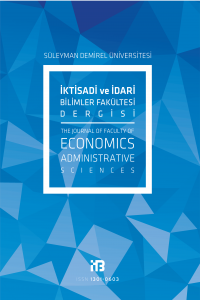TÜRKİYE MUHASEBE STANDARTLARINA GÖRE İNTERNET SİTESİ MALİYETLERİNİN MUHASEBELEŞTİRİLMESİ
İnternet Sitesi, Maddi Duran Varlıklar, Maddi Olmayan Duran Varlıklar, Türkiye Muhasebe Standartları
KOBİ'lerde Entelektüel Sermayenin İşletme Performansına Etkisi
-,
___
- 1. AKGEMİCİ, T. (2001), Kobi’lerin Temel Sorunları ve Sağlanan Destekler, KOSGEB Yayınları, Ankara.
- 2. BAGOZZI, R.P. (1998), “Measurement in Marketing Research”, Principles of Marketing Research, Richard P. Bagozzi Edition, Blackwell Publishers, Cambridge, 1-49.
- 3. BOLLEN, L., VERGAUWEN, P., VE SCHNIEDERS, S. (2005), “Linking intellectual capital and intellectual property to company performance”, Management Decision, 43 (99, 1161-1185.
- 4. BONTIS, N. (1998) “Intellectual capital: an exploratory study that develops measures and models”, Management Decision, 36 (2), 63-76.
- 5. BONTIS, N., KEOW, W.C.C. ve RICHARDSON, S. (2000), “Intellectual capital and business performance in Malaysian industries”, Journal of Intellectual Capital, 1 (1), 85-100.
- 6. BROOKING, A. (1996), Intellectual Capital : Core Assets for the Third Millennium Enterprise, Thomson Business Press, London.
- 7. BROOKING, A. (1997), “The Management of Intellectual Capital, Long Range Planning, 30 (3), 364-365.
- 8. CHEN, M-C, CHENG, S.J. VE HWANG, Y. (2005), An empirical investigation of the relationship between intellectual capital and firm’s market value and financial performance”, Journal of Intellectual Capital, 6 (2), 159-176.
- 9. CHEN, Y.-S., JANESTIN, M.-J., ve CHONG, C.-H. (2006), “The Influence of Intellectual Capital on New Product Development Performance _ The Manufacturing Companies of Taiwan as an Example”, Total Quality Management & Business Excellence, 17 (10), 1323-1339.
- 10. CLAESSEN, E. (2005), “Strategic use of IC reporting in small and medium-sized IT companies – A progress report from a Nordic project”, Journal of Intellectual Capital, 6 (4), 558-569.
- 11. DPT (2004), Kobi Startejisi ve Eylem Planı, http://ekutup.dpt.gov.tr/ esnaf/kobi/starateji.pdf, (14.05.2007).
- 12. EDVINSSON, L. ve SULLIVAN, P. (1996), “Developing a model for managing intellectual capital”, European Management Journal, 14 (4), 356-364.
- 13. EDVINSSON, L. ve MALONE, M. (1997), Intellectual Capital : Realizing your company’s true value by finding its hidden brainpower, Harper Business, New York.
- 14. EUROPEAN COMMISSION, (2006), Reporting Intellectual Capital to Augment Research, Development and Innovation in SMEs, Directorate - General for Research of European Commission, Brussels.
- 15. GUTHRIE, J. (2001), “The management, measurement and the reporting of intellectual capital, Journal of Intellectual Capital, 2 (1), 27-41.
- 16. HUANG, C. J. ve LIU, C. J. (2005), “Exploration for the relationship between innovation, IT and performance, Journal of Intellectual Capital, 6 (2), 237-252.
- 17. MERTINS, K., ALWERT, K. ve WILL, M. (2006), Measuring Intellectual Capital in European SME”, Proceeding of I-KNOW’06, Graz, Austria, September 6-8.
- 18. OECD (2004), Small and Medium-Sized Enterprises in Turkey – Issues and Policies, OECD Publications, Paris, France.
- 19. KOSGEB, (2006), 2006 Yılı Çalışma Programı, Ankara.
- 20. LYNN, B. E. (1998), “Intellectual capital”, CMA, 72 (1), 10-15.
- 21. LYNN, B. E. (2000), “Intellectual capital”, Ivey Business Journal, 64 (3), 48-52.
- 22. MERITUM, (2001), Guidlines for Managing and Reporting on Intangibles (Intellectual Capital Report), Final Report of the MERITUM Project, EU.
- 23. MONTEQUIN, V.R., FERNANDEZ,F.O., CABAL, V.A. ve GUTIERREZ, N.R. (2006), “An integrated framework for intellectual capital measurement and knowledge management implementation in small and medium-sized enterprises, Journal of Information Science, 32 (6), 525-538.
- 24. ÖZDAMAR, K. (1999), Paket Programlar ile İstatistiksel Veri Analizi, İkinci Basım, Kaan Kitapevi, Ankara.
- 25. ROOS, G. ve ROOS, J. (1997), “Measuring Your Company’s Intellectual Performance”, Long Range Planning, 30 (3), 413-426.
- 26. ROOS, J., ROOS, G. DRAGONETTI, N.C. VE EDVINSSON, L. (1997), Intellectual Capital: Navigating the new business landscape, Macmillan Press Ltd., London.
- 27. SALOJÄRVI, S. (2005), Increasing Knowledge Focus-A Means for Entrepreneurs to Remain on a Growth Path. Essys on the Role and Nature of Knowledge Management in Finnish SMEs, Prima Ltd., Helsinfors.
- 28. SALOJÄRVI, S., FURU, P. ve SVEIBY, K.E. (2005), “Knowledge Management and Growth in Finnish SMEs”, Journal of Knowledge Management, 9 (2), 103-122.
- 29. STEWART T. A. (1991), “Brainpower: how intellectual capital is becoming America’s most valuable asset” FORTUNE, June 3, 44-60.
- 30. STEWART T. A. (1997), Entellektüel Sermaye- Kuruluşların Yeni Zenginliği, (Nurettin Elhüseyni), BZD Yayıncılık, İstanbul.
- 31. SVEIBY, K.E. (1997), The New Organisational Wealth:Managing and Measuring Knowledge-Based Assets, Berrett-Koehler Publishers Inc., San Francisco, CA.
- 32. TAN, H.P., PLOWMAN, D. Ve HANCOCK, P. (2007), Intellectual capital and financial returns of companies, Journal of Intellectual Capital, 8 (1), 76-95.
- 33. WANG, W-Y ve CHANG, C. (2005), “Intellectuala capital and performance in causal models - Evidence from the information technology industry in Taiwan”, Journal of Intellectula Capital, 6 (2), 222-236.
- ISSN: 1301-0603
- Yayın Aralığı: Yılda 3 Sayı
- Başlangıç: 1996
- Yayıncı: Süleyman Demirel Üniversitesi
Yrd.Doç.Dr.Murat KAYALAR, Öğr.Gör.Dr. N.Metin ÖZMUTAF
BELEDİYE PERSONELİNİN HİZMET İÇİ EĞİTİM SORUNU: BİR ARAŞTIRMA VE MODEL ÖNERİSİ
ÖRGÜT KÜLTÜRÜNÜN ÖRGÜT İÇİ BİREYSEL BECERİLERİN KULLANIMINA ETKİSİ ÜZERİNE BİR ARAŞTIRMA
Yrd.Doç.Dr.Yavuz DEMİREL, Yrd.Doç.Dr.Himmet KARADAL
AVRUPA İNSAN HAKLARI SÖZLEŞMESİ’NDE DERNEK ÖZGÜRLÜĞÜ
Yrd.Doç.Dr.Yüksel METİN, Gamze ASLAN
Dr.Mehmet AKSARAYLI, Yrd.Doç.Dr.Haluk EGELİ, Prof.Dr.Kâmil TÜĞEN, Prof.Dr.H.Ahmet AKDENİZ, Arş.Gör.Ahmet ÖZEN
TÜRK TİCARET KANUNU (TTK) VE TTK TASARISI AÇISINDAN HAKSIZ REKABET HÜKÜMLERİNE BİR BAKIŞ
KAPİTALİST SİSTEMİN SÜRÜKLEYİCİ AKTÖRLERİ: EKONOMİK TEORİDE GİRİŞİMCİLER
TÜRKİYE’DE GELİR VE KURUMLAR VERGİSİ ORANLARINDA İNDİRİMİN VERGİ GELİRLERİ ÜZERİNE ETKİLERİ
TÜRKİYE'NİN DÖVİZ KURUNUN BELİRLENMESİNDE MONETARİST YAKLAŞIM
Doç.Dr.M.Vedat PAZARLIOĞLU, Selçuk GÜLOĞLU
YÖNETİŞİM TARTIŞMALARINA KATKI: AVRUPA BİRLİĞİ İÇİN YÖNETİŞİM NE ANLAMA GELİYOR?
